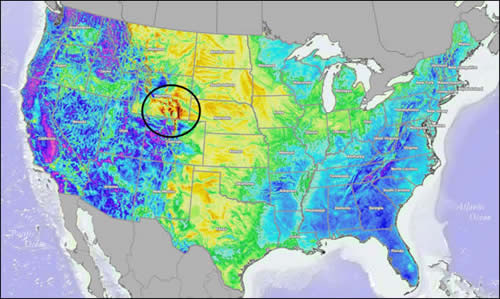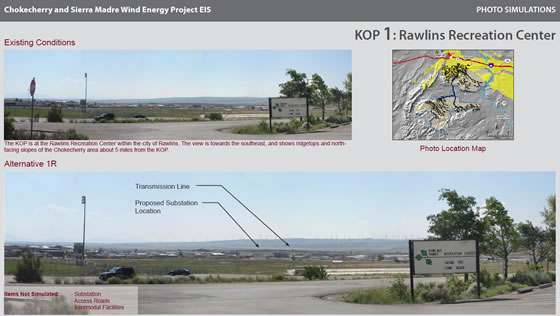About the CCSM Project
The Chokecherry and Sierra Madre Wind Energy Project is an approximately 3,550 MW wind power plant that will provide a reliable supply of wind-generated electricity that's unmatched in the nation. About half of the project is located on private land in Wyoming’s "checkerboard," and half is located on federal/state land. All BLM environmental analysis is completed; all major federal and state permits are secured; and a well-prepared, well-planned construction program is making this one-of-a-kind wind project a reality while creating good jobs for Wyoming workers and assuring environmental protection. The BLM rights-of-way and notices to proceed were issued 2016-2020. This project is under construction.
In addition, this wind project will:
- Provide zero-fuel-cost, zero-emissions electricity.
- Support national and regional renewable energy goals, such as state-mandated Renewable Portfolio Standards and greenhouse-gas reduction targets.
- Capture and leverage natural resources wisely and responsibly.
- Create thousands of construction jobs and an estimated 114 permanent operations and maintenance jobs.
- Contribute millions in property taxes and sales and use taxes, among other economic benefits.
Wyoming wind
Wind and solar infrastructure have been cited in numerous studies as the most economic large-scale resource alternatives to meet the renewable and clean energy demands throughout the country and in the Desert Southwest.
According to the National Renewable Energy Lab, southeast Wyoming has one of the densest concentrations of high class wind energy potential in the country. NREL data shows that over 50 percent of the best quality (Class 6 and 7) wind capacity in the continental United States is located in Wyoming. This Class 6 and 7 wind resource has an energy potential of 235,000 GWh/yr.
In the specific Chokecherry and Sierra Madre proposed project area, NREL data shows the wind power resource potential as "excellent," "outstanding" and "superb." Only 2% of the land area in the continental U.S. has average annual wind speeds above 8.5 meters/second at 80 meters above ground, according to AWS Truewind. Of that amount, 25% of the best winds are in Wyoming, and 5% are in Carbon County.

This wind resource map shows the mean annual wind speed measured at 80 meters.
Dark orange represents winds of 8 meters per second, and speeds increase
as the orange-red gets darker. (Map by AWS Truewind)
Many electric industry analyses such as those by the Western Electricity Coordinating Council, Western Electric Industry Leaders and National Grid, have looked specifically at regional renewable energy alternatives, including remote resources supplied through new transmission infrastructure, to meet the needs of the Desert Southwest. Wyoming wind resources were identified as one of the most economic alternatives to meet a portion of the overall needs.
What does the project look like?
Once a novelty in the American landscape, views of slim turbine blades sweeping through the air are now familiar as the country aims to increase its production of clean energy. The Chokecherry and Sierra Madre turbines will be installed starting about 3 miles south of Rawlins and Sinclair, Wyoming, on a 320,000-acre ranch owned by an affiliate of The Anschutz Corporation. However, total long-term surface disturbance is estimated to be less than 1,500 acres since wind turbines have a small footprint. Because of their proposed locations, the vast majority of the project’s wind turbines will not be visible from public access points in Carbon County. The CCSM Project wind turbines are being developed in two phases.

Wind turbines generally have towers up to 390 feet tall, from base to nacelle, in order to capture more energy per turbine. Aerodynamically-designed blades can be up to 265 feet long. (Final turbine models for the CCSM Project will not be selected until closer to construction.) As wind spins the blades, they power a generator that converts the energy into clean electricity that can be transmitted to utility customers.
As part of the July 2011 Draft EIS, Bureau of Land Management prepared a series of visual simulations to show what the wind energy project may look like from various vantage points in Carbon County. The visual simulations are available on the BLM website.

A visual simulation from the Draft EIS.
By the numbers
- About 600 wind turbines
- About 3,500 MW nameplate capacity
- Best winds in the country – Class 6-7
- $5 billion estimated cost
- About 50% sited on private land and 50% on federal land in Carbon County "checkerboard"
Stay informed
![]() Join our email list to receive periodic updates and meeting notifications.
Join our email list to receive periodic updates and meeting notifications.
 Follow us on X/Twitter for updates.
Follow us on X/Twitter for updates.